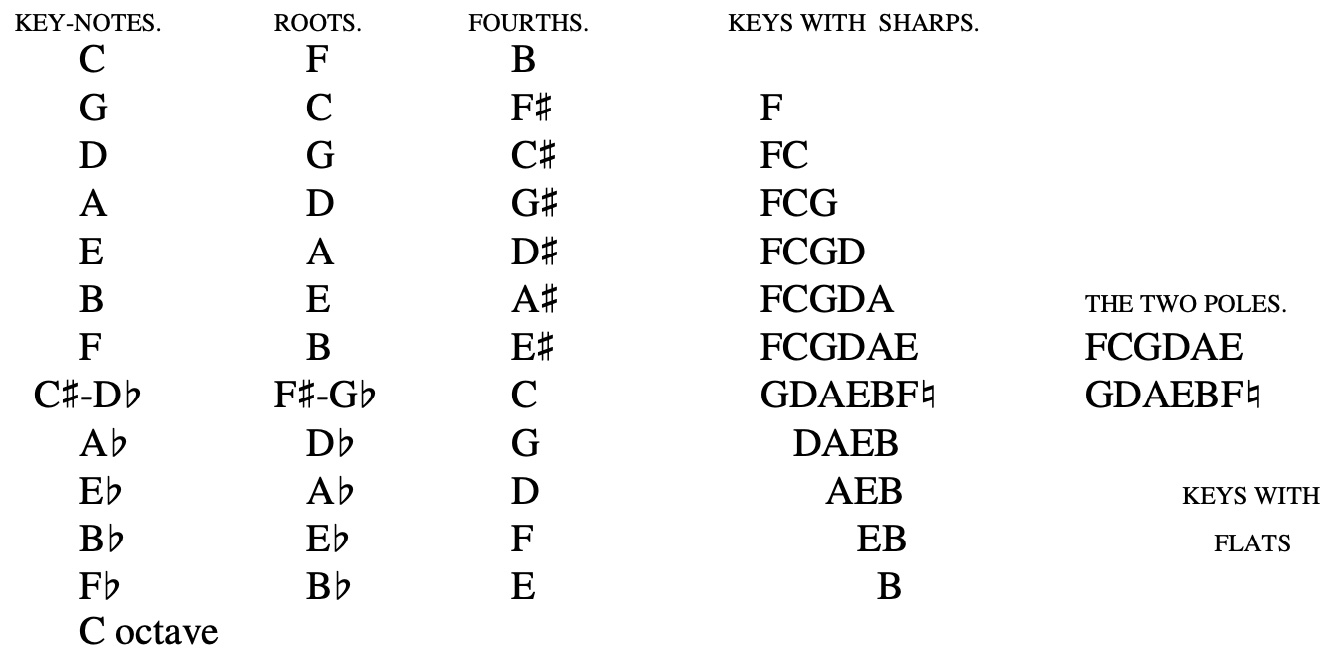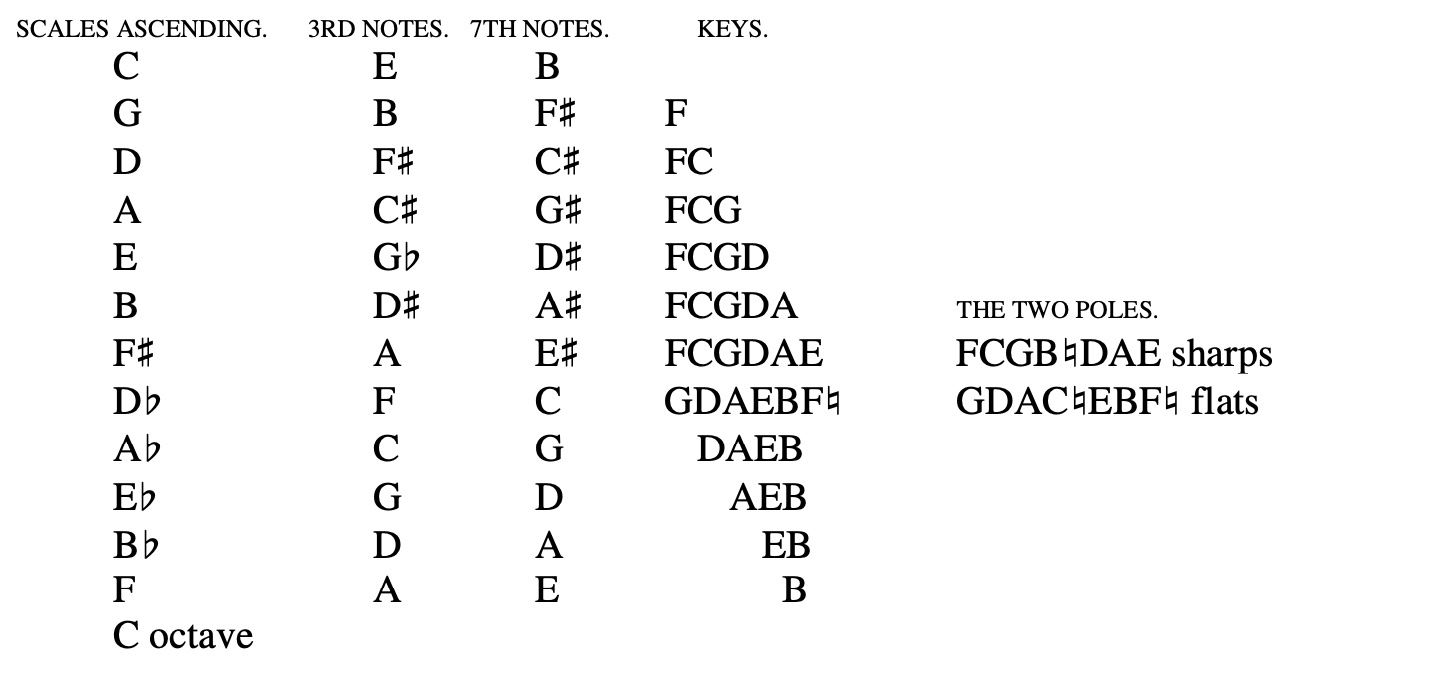Ramsay
In a similar and responsive way Duality provides for the six major scales with flats.
The two new notes required for the scale of
F major are the B? of D, and the D of A minor;
for B? major, the E? of G, and the G of D minor;
for E? major, the A? of C, and the C of G minor;
for A? major, the D? of F, and the F of C minor;
for D? major, the G? of B?, and the B? of F minor;
for G? major, the C? of E?, and the E? of B? minor.1 [Scientific Basis and Build of Music, page 90]
sexual note in the scales of G major and E minor are the two A's; in D major and B minor, the two E's; in A major and F# minor, the two B's; in E major and C# minor, the two F's; in B major and G# minor, the two C's; and in F# major and D# minor, the two G's. These two last scales being the beginning of a second cycle of twelve scales when the scales are written half in flats and half in sharps, as we have done them in this case. Turning to the other half of our circle, those which we have, and which usually in music books are, written in flats, in F major and D minor the sexual notes are the two G's; in B? and G, the two C's, in E? and C, the two F's; in A? and F, the two B's; in D? and B?, the two E's; and in G? and E?, the two A's. [Scientific Basis and Build of Music, page 91]
The inner stave contains the chromatic scale of twelve notes as played on keyed instruments. The flat and sharp phase of the intermediate notes are both given to indicate their relation to each other; the sharpened note being always the higher one, although seemingly on the stave the lower one. The two notes are the apotome minor apart overlapping each other by so much; ?D is the apotome lower than C#; ?E the apotome lower than D#; F# the apotome higher than ?G; G# the apotome higher than ?A; and A# the apotome higher than ?B. The figures for the chromatic scale are only given for the notes and their sharps; but in the mathematical series of notes the numbers are all given. [Scientific Basis and Build of Music, page 120]
Hughes
The difference in the development of a major and a minor harmony
—The twelve developing keys mingled
—D? shown to be an imperfect minor harmony
—E? taking B? as C? to be the same as D#
—The intermediate tones of the seven white notes are coloured, showing gradual modulation
—As in the diagram of the majors, the secondaries are written in musical clef below the primaries, each minor primary sounding the secondaries of the third harmony below, but in a different order, and one tone rising higher, . . . . . 34 [Harmonies of Tones and Colours, Table of Contents3 - Harmonies]
study of the natural sciences, as we progress, we find that "hills peep o'er hills, and alps o'er alps arise." As regards keyed instruments, it appears that the effect of those notes which act two parts, such as C# and D?, is rectified in some way so as to be perfectly attuned to the ideal of harmony within us. Again, the "Amen" sung by the choir in a cathedral may not be in accurate tune, but if nearly the correct intonation is sounded, after traveling along the aisles, the chords always return to the ear in perfect harmony, because the natural laws of music, assisted by the echoing power of the building, have attuned them to the perfect harmonical triad. If the "Amen" be too much out of tune, these laws decline to interfere, and there is no such helpful resonance.* [Harmonies of Tones and Colours, The Method of Development or Creation of Harmonies2, page 16]
We here trace the twelve harmonies developing in succession. Notice how exactly they all agree in their mode of development; also the use of the chasms between E and F, B and C. Remark also the beautiful results from the working of the double tones, especially C#-D?, and E#-F?, causing the seven tones of each harmony, when ascending, to rise one tone, and, descending, to reverse this movement. F#-G? is the only double tone which acts as F# when a key-tone, and G? when the root of D?. The root of each harmony is the sixth and highest tone in each succeeding harmony, rising one octave; when it is a double tone, it sounds according to the necessity of the harmony. The intermediate tones are here coloured, showing gradual modulation. The isolated fourths (sounding sevenths) were the previously developed key-tones; these also alter when they are double tones, according to the necessity of the harmony. Beginning with B, the isolated fourth in the harmony of C, the tones sound the twelve notes of a keyed instrument, E# being F?, and the double tones, some flats, some sharps. [Harmonies of Tones and Colours, Combinations of dissonance, rests, page 24]
We find that on a keyed instrument each primary sounds the same tones as the secondaries of each third harmony below, but in a different order, and the double tones are altered sharp or flat as the harmony requires. For example, the secondaries of B are sharps; when primaries of D?, they are flats. In order to trace this quickly, the sharps and flats are written to each note. [Harmonies of Tones and Colours, Combinations of dissonance, rests, page 24]
ON a keyed instrument only twelve are major key-notes, but as the double tones C#-D? and F#-G? are roots, there are fourteen different chords. The fourteen that are roots are written in musical clef. As an example of the major chords in the different keys, we may examine those in the key of C. A major fifth includes five out of the seven of its key; with the third or central note it is the threefold chord, or fourfold when the octave note is added. Including the silent key-notes, a threefold chord embraces eight, or, counting the double tones, not including E#, eleven. The first and second chords of the seven of the harmony are perfect major chords in the key of C; the central note of the third chord, being #C-?D, is a discord. The first pair of fifths in the scale, with its central note, is a chord of the key; if we include the octave, the last pair of fifths, with its central note, is the same chord an octave higher than the lowest chord of the seven. Of the chords written in musical clef of the twelve keys, the octave chord is only written to C, the seven of each having two chords and the scale one, thirty-six in all, or forty-eight if the octave chords are added. Notice how the chords of each seven and the chord of its scale are altered. [Harmonies of Tones and Colours, Diagram V - The Chords of the Twelve Major Keys, page 27a]


When the twelve minor harmonies are traced developing in succession, we notice how exactly they all agree in their method of development, also the use of the chasms and the double tones, the seven of each harmony rising a tone when ascending, but reversing the movement in descending; keys with sharps and those with flats are mingled. The intermediate tones are here coloured, showing gradual modulation. D? is shown to be an imperfect minor harmony, and E?, by employing B as C?, is seen to be equivalent to D#. [Harmonies of Tones and Colours, Diagram IX - The Minor Keynote A and Its Six Notes, page 34a]
The diagram represents the Minor Key-note A and its 6 notes veering round in trinities; A and the other 11 developing their trinities in musical clef. Below each is the order in which the pairs unite, avoiding consecutive fifths, Lastly, D? is shewn to be an imperfect minor harmony, and by employing B as C?, E? is seen to be the same harmony as D#. As before, it should be remembered that the sharp and flat notes should, strictly, have intermediate tints. [Harmonies of Tones and Colours, The Diagram Represents the Minor Keynote, page 34c]
See Also
